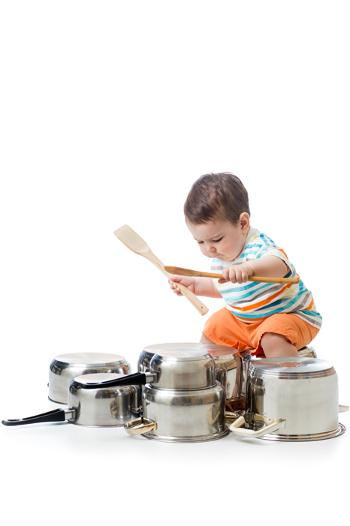Shake, rattle, roll
Duration/age

Crash, bang, play and sing. Let’s make an orchestra.
Your home is full of things that you can use to make music. Your child can help you find all sorts of possibilities in the saucepan and plastics cupboards.
Saucepans and large mixing bowls make fantastic drums. They could use a wooden spoon or their hands to make music. Two saucepan lids make a pair of cymbals. A funnel makes a trumpet.
Recycled plastic bottles, small boxes or little yogurt containers can be turned into shakers. Just put something small inside that will make a sound. Try using rice, dried chickpeas or little stones.
Pour the beans in slowly. How much should we fill it?
Tape the lids shut and shake. Help your child listen for the different sounds.
This one sounds loud. Can you find one that makes a soft sound?
Make a hole in the bottom of a tin can and thread a string through it. Cover any sharp edges with thick tape. Hang the can up and bang it with a stick or spoon. Do different cans make different sounds? What happens if you tie some bells inside the can?
Next time you have an empty tissue box or shoebox try stretching some rubber bands over it. This makes a kind of guitar. Show your child how to strum or pluck the strings to make the music.
Materials you will need
- Boxes
- Wooden spoon
- Small containers
- Wooden sticks
- Funnels
- Plastic containers
- Tape
- Saucepans, pots and pans
- Beans, seeds, sand and stones
- Tin cans
- Rubber bands
Skills this activity improves
Why does this matter?
When you and your child are making and playing with musical instruments they will be exploring and experimenting with sound. They will be working out how different materials sound, like beans and sand in shakers, or small saucepans compared to big ones.
They will be developing listening skills as they hear the instruments.
You child will be developing motor skills as they manipulate the instruments. When they are drumming and when they are making the instruments they will be using both their big and small muscles.
What does this lead to?
Exploring and experimenting is one way that we learn how things work. Children particularly learn best when they have hands-on experiences. Trying out one way of doing something to see if it works and then trying something else is a good learning skill. For example, putting lots of beans in a shaker may not work as well as just putting a few in.
Being able to listen and to tell the difference between sounds is an important part of communication.
Having good motor skills helps children when they are learning to write.
Language to use
- Drum, beat, pound
- Loud, soft, louder, softer, quiet
- Shake, music shaker, maracas
- Crash, bang, chime, tinkle
- Ding, ring, ting
- Tape, container, tin can
- Beans, rice
Questions to use
- How many drums can you play at one time?
- Let’s count out 20 chickpeas. Do you think that will that be enough?
- Where should we hang the tin can? Can you reach it there?
Useful tips
- For safety information visit www.parenting.sa.gov.au
- You might also like to take a look at the activities Friday night dance party and Let's dance.
- Remember to talk to your child in your home language.
More ideas
Your child could decorate the shakers or tin cans. They could use paint, paper, glitter or bits of fabric.
Variation by age
Birth to two year olds
- If your baby is too young to hold a rattle you can shake it for them. Shake the rattle on each side and above their head. Your baby will search to try and find where the sound is coming from.
Three to five year olds
- Make a band. Give everyone in your family an instrument to play. Put on some music and play along.
Questions to ask
- Can you hear that? Where is that sound coming from now?
Language to use
- Beat, time, play
Language to use
- Here, over there, over here
- Shake, rattle


